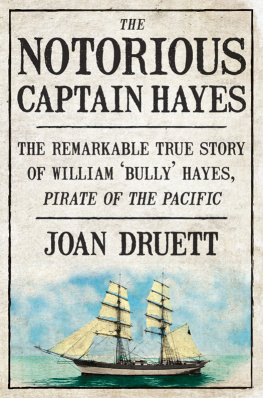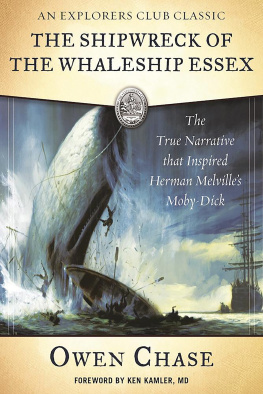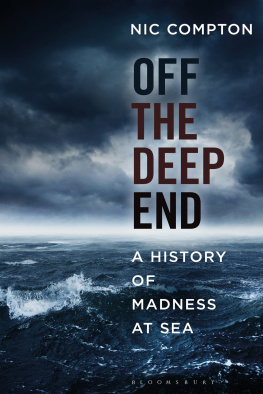Praise for In the Wake of Madness
Joan Druett pulls off an unlikely feat: she delivers both a primer on nineteenth-century whaling, complete with Moby-Dick resonances, and a genuine nautical thriller, a page-turner. She takes us along on this doomed voyage, building to a climax that is shocking and very satisfying.
RICHARD ZACKS, author of The Pirate Hunter:
The True Story of Captain Kidd
Masterfully weaves the history of whaling and sailing with a detailed murder investigation.
Richmond Times-Dispatch
[Druett] draws a fine picture of the floating community of whalers and deserters.
The New York Times Book Review
A nautical murder mystery.
USA Today
Those who enjoy maritime history, whaling, and Melville should embark on the Sharon book voyage for a thrilling ride.
Good Old Boat
A fascinating historical, action-packed tale of high seas adventure.
The Westerly Sun
Gripping.... Brings alive Herman Melvilles description of the high seas and of the characters who inhabit the vessels that sail it.
The Sunday Oklahoman
Stunning. [Druett] writes about maritime history with the delicious ease and nail-biting suspense of a crack mystery novelist.
The Standard-Times
This book would make a wonderful movie.... First-rate
ForeWord magazine
Druett has written an interesting work of creative non-fiction. Readers wont need to read beyond the introduction to know whats going to happen. Her hook is not what, but how this tragedy happened. Its more than enough to keep readers engaged.
The Virginian-Pilot
A terrific account of an unusually eventful voyage.
Publishers Weekly
A sharp harpoon, a keen eye, an unerring throw.
Kirkus Reviews
An informative and vividly re-created picture of Americas maritime past.
Library Journal
A must read in maritime history.... Druetts prose, imagery and use of primary sources bring to life this lost American experience.
The Great Lakes Historical Society
Though this is a work of history, it reads fast, like a novel. In the Wake of Madness is easily one of the best-written books of popular history Ive ever read.
JESSICA POWERS, NewPages
In addition to its gripping narrative, Druetts book provides a virtual encyclopedia of life (and death) on whalers in the 1800s.
The Dukes County Intelligencer
Anyone who enjoys maritime history, the works of Melville or a good yarn will love this literate, entertaining book.
Pawling News Chronicle
Like a combination primer in nautical life in the 1800s and a slowly building drama, author Joan Druetts book is a powerful true historical account.... You need not have read Moby-Dick, or be partial to nautical history or fiction, to find In the Wake of Madness a captivating book.
The Decatur Daily
Druett is a fine historian.
The Boston Globe

ALSO BY JOAN DRUETT
Rough Medicine
She Captains
Hen Frigates
The Sailing Circle (with Mary Anne Wallace)
Captains Daughter, Coastermans Wife
She Was a Sister Sailor (editor)
Petticoat Whalers
Fulbright in New Zealand
Exotic Intruders
Island of the Lost

IN THE WAKE OF MADNESS
THE MURDEROUS VOYAGE OF THE WHALESHIP SHARON
BY
JOAN DRUETT
Algonquin Books of Chapel Hill
Published by
ALGONQUIN BOOKS OF CHAPEL HILL
Post Office Box 2225
Chapel Hill, North Carolina 27515-2225
a division of
Workman Publishing
225 Varick Street
New York, New York 10014
2003 by Joan Druett. All rights reserved.
Illustrations by Ron Druett.
Map by Ron Druett and Laura Williams.
Library of Congress Cataloging-in-Publication Data is available for a previous edition of this work.
E-book ISBN 978-1-56512-756-2
Human madness is oftentimes a cunning and most feline thing.
When you think it fled, it may have become transfigured into still subtler form.
HERMAN MELVILLE, Moby-Dick
CONTENTS

INTRODUCTION
On May 25, 1841, the whaleship Sharon of Fairhaven, Massachusetts, set out on the first leg of what was to become one of the most notorious voyages of the nineteenth centuryand yet one of its best-kept secrets. She was bound for the whaling grounds of the northwestern Pacific, where many small tropical islands lay scattered in an immensity of sea. In charge of the quarter deck were three men from the island of Marthas VineyardCaptain Howes Norris and his first and second officers, both named Smith.
Earlier that year, on January 3, a sister whaleship, the Acushnet, had worked her way out of just the same bay. Her captain was another Vineyard man, Valentine Pease Jr., and among her crew was an aspiring writer, Herman Melvillea young man whose Pacific adventures, along with the stories he heard from other whalemen, would provide background and inspiration for his great novel, Moby-Dick.
Leaving Fairhaven in January, the Acushnet had steered south for Cape Horn, at the southernmost extremity of South America, to battle headwinds on the way to the eastern Pacific, where she would hunt whales off Chile and Peru and reprovision at the Marquesas Islands. These were waters that Melville came to know wellthe same Cape Horn route and the same waters that were sailed by the Nantucket whaleship Essex, which was sunk by a whale in November 1820, providing the inspiration for the ultimate fate of Melvilles fictional Pequod, though not for her course.
In Moby-Dick, Captain Ahab took the opposite route to Captain Pease of the Acushnet. He steered for the Cape of Good Hope, at the bottom of Africa, and then traversed the Indian Ocean to the East Indies, to negotiate the shoals and reefs there before breaking into the Western Pacific. Ahabs route was exactly the same as that followed by Norris of the Sharon, who hunted sperm whales in the same seas where Captain Ahab pursued the great white whale.
And Norris of the Sharon, like Ahab of the Pequod, was headed for disaster.
THE EARLIEST NOTICE of Norriss gruesome fate appeared in the Shipping Intelligence column of the Sydney Morning Herald, on December 23, 1842. The Sharon has put in to obtain hands, and also on account of the murder of her late commander, Captain Norris, the announcement ran. Behind this bald statement lay a story so sensational that it raced across the world as fast as wind could fill sails, creating headlines wherever it went and gripping the imagination of the public.
The path to calamity had been laid on October 15, 1842, when the Sharon arrived at Ascension Islandnow called Pohnpeiin the tropical northwest Pacific. Typical of the Pacific paradises that young men dreamed of before they joined the crews of whalers, it was also a favorite spot for absconding from the shipbut not desertion on the scale experienced by the captain of the
Next page














